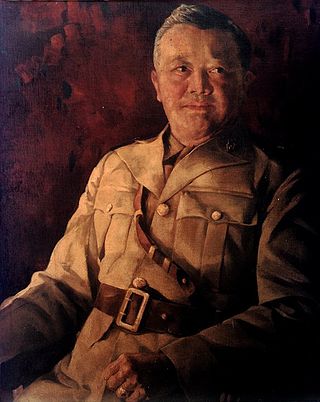
The Philippine Constabulary was a gendarmerie-type military police force of the Philippines from 1901 to 1991,and the predecessor to the Philippine National Police. It was created by the American occupational government to replace the Spanish colonial Guardia Civil,happened on the 19th century history of the Philippines. It was the first of the four branches of the Armed Forces of the Philippines. On January 29,1991,it was merged with the Integrated National Police to form the Philippine National Police.

The Philippine Revolutionary Army,later renamed Philippine Republican Army,was the army of the First Philippine Republic from its formation in March 1897 to its dissolution in November of 1899 in favor of guerrilla operations in the Philippine–American War.

Antonio Mario Taguba is a retired major general in the United States Army. He was the second American citizen of Philippine birth to be promoted to general officer rank in the United States Army.

The Philippines campaign,also known as the Battle of the Philippines or the Fall of the Philippines,was the invasion of the American territory of the Philippines by the Empire of Japan and the defense of the islands by United States and the Philippine Armies during World War II.

Vicente Podico Lim was a Filipino brigadier general and World War II hero. Lim was the first Filipino graduate of the United States Military Academy at West Point. Prior to the establishment of the Philippine Army,he served as an officer in the Philippine Scouts. During the Battle of Bataan,Lim was the Commanding General of the 41st Division,Philippine Army (USAFFE). After the fall of the Philippines he contributed to the Filipino resistance movement until his capture and subsequent execution.

Alfredo Manapat Santos was Chief of Staff of the Armed Forces of the Philippines in 1962 to 1965,making him the first four-star general of the Philippines' armed forces.

The 2nd Infantry Division,Philippine Army nicknamed Jungle Fighter,is the Philippine Army's primary infantry unit specializing in jungle warfare.
Eulogio Balauitan Balao was a Filipino soldier and politician.

Voltaire Tuvera Gazmin is a retired Filipino soldier who was the 35th Secretary of the Department of National Defense of the Philippines. Gazmin assumed office on 1 July 2010,after President Benigno S. Aquino III had issued the former's appointment the day before.

Brigadier General Virgilio Norberto Cordero Jr. was a Puerto Rican soldier who served in the United States Army. Cordero authored two books about his experiences as a prisoner of war,and his participation in the Bataan Death March of World War II.

Ernesto S. Mata was a Filipino General and the 15th Secretary of National Defense of the Republic of the Philippines,serving in that capacity from 21 January 1967 to 3 February 1970.

The 11th Infantry Division was one the reserve division of the Philippine Army that was mobilized in September 1941 under the United States Army Forces in the Far East (USAFFE).

Eduardo "Ed" Drueco del Rosario is a Philippine Army veteran and government official who served as the first Secretary of Human Settlements and Urban Development of the Philippines under the Duterte administration,from January 2,2020 to June 30,2022. He previously served as Chairperson of the now-defunct Housing and Urban Development Coordinating Council which was abolished and replaced by the Department of Human Settlements and Urban Development created through Republic Act No. 11201 on February 14,2019. Del Rosario served 37 years in the Armed Forces of the Philippines,retiring as a major general in 2012. His service included tours as commander of the AFP Southern Luzon Command and of the 2nd Infantry Division.

Guillermo Beato Francisco was a Filipino military officer who served in the Philippine Constabulary and the Philippine Army. He was the Chief of Philippine Constabulary in 1938 until 1941. His constabularies were absorbed by the Army and he commanded the 2nd Regular Division (Philippines) during the invasion by Japan,and then survived the Bataan Death March. Paroled from prison,Francisco continued to be a constabulary leader during the Japanese occupation.

Calixto Duque was a Filipino decorated military officer and a WW II veteran who served as Chief of Staff of the Armed Forces of the Philippines from 1951 to 1953 after his retirement. He also served as Vice Chief of Staff from 1949 to 1951 and Deputy Chief of Staff from 1946 to 1949.
Alfonso Viterbo Arellano was a Filipino army officer who served as AFP Chief of Staff from 1956 to 1958. He was a World War II veteran and decorated soldier. He was appointed by President Ramon Magsaysay a fellow WW II hero.
Tirso Gimenez Fajardo was a Filipino Army General who served as 2nd Commanding General of the Philippine Army.
Visayas-Mindanao Force was a military formation created in November 1941 to command all soldiers of US Army,US Philippine Scouts,Philippine Army,and Philippine Constabulary in the southern islands of the Philippines. Colonel William F. Sharp was appointed as commanding general and was promoted to Brigadier General in November 1941 and later Major General. His executive officer was Major Howard Edmands. He was just starting to organize his command and train his soldiers into a fighting unit when the war started on December 7,1941.
51st Field Artillery Regiment is a reserve unit of Philippine Commonwealth Army activated and organized in 1941 and fought during World War II. The regiment is a component of 51st Infantry Division under Brigadier General Albert M. Jones,responsible for the defense of Bicol Peninsula.

Rigerto Atienza (1911–1966) was a general of the Philippine Army who became 13th chief of staff of the Armed Forces of the Philippines and Commanding General of Philippine Army prior during the administration of President Diosdado Macapagal.













